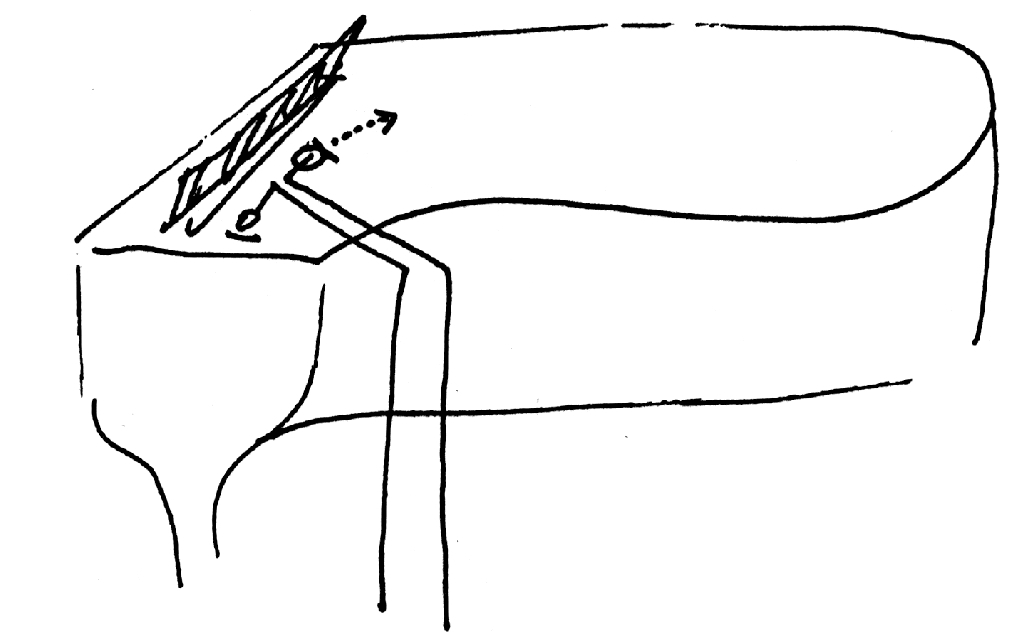
GRUPPEN for 3 orchestras - supplement
Stockhausen Complete Edition on CD
Since 1991, a complete edition of all recordings in which Karlheinz Stockhausen has personally participated is being released on compact discs. Each CD in this series is identified by Stockhausen's signature followed by an encircled number. The numbers indicate the general historical order of the works.
Stockhausen realised the electronic music and participated in these recordings as conductor, performer, sound projectionist, and musical director. He personally mixed down the recordings, mastered them for CDs, wrote the texts and drew the covers.
- The compact discs may be obtained from the Stockhausen-Verlag: Kettenberg 15, 51515 Kuerten, Germany (www.stockhausenCDs.com).
Karlheinz Stockhausen
GRUPPEN (GROUPS) for 3 orchestras
performance practice supplement
(October 5th 1996)
For all tutti rehearsals, each of the three conductors needs a microphone and a monitor loudspeaker to be able to communicate with the other two conductors, but his own microphone should not be circuited to his own monitor (danger of feed-back). This circuiting must be ready and tested before the first tutti rehearsal.
Sound projectionist for the tutti rehearsals
During the past several years, I have occasionally participated in the tutti
rehearsals of GRUPPEN for 3 orchestras from the middle of the hall during
the final three days preceding a performance. In the course of these rehearsals,
the conductors realised how important it was – and they have suggested
for the future – to have a sound director in the middle of the hall who
balances the dynamics, communicates with the conductors about other corrections,
and, in general, leads the rehearsals, speaking over a microphone,
with monitor loudspeakers on each podium.
It is a fact, that the three conductors cannot judge, from their respective
positions, how the dynamic levels sound in the hall, and what the actual effect
is of "hard" and "soft" beaters (percussion) within the ensemble. The
sound director must be completely familiar with the work and the score, be
able to communicate concisely and lead the rehearsals clearly, and be chosen
by the three conductors. He (she) should also control the microphone amplification
of the guitar and piano (in orchestra II) using a small mixer at the
middle of the hall, and attend (ahead of time) to the set-up of the 3 microphones
(1 for guitar, 2 for piano treble-bass) and the installation of 2 x 2
loudspeakers, which are hung or set up (circa 4 m high) at the left and right
next to orchestra II.
The sound director should be assisted by two musicians who constantly judge the dynamic level from all seats in the hall, and regularly inform him how the dynamics sound from all seats.
One of the three conductors must visit the performance venue when a performance of GRUPPEN has been definitively planned. He (she) must also have a detailed discussion with the percussionists and check all percussion instruments, celesta, glockenspiel etc. Experience has repeatedly shown that the pitches of the percussion instruments were wrong. In addition, the orchestra parts must be checked by the conductors ahead of time, because every now and then, uncorrected rental material is delivered.
Supplement to the GRUPPEN score
The dynamic degrees  must be rehearsed in such a
way that
must be rehearsed in such a
way that  can be clearly heard even in the last row of seats. Generally,
can be clearly heard even in the last row of seats. Generally,
 are played too softly;
are played too softly;  must be quite intense.
must be quite intense.
 in the percussion must be balanced with the other instruments,
especially when hard beaters are being used.
in the percussion must be balanced with the other instruments,
especially when hard beaters are being used.  simultaneously
indicated for percussion and for other instruments must be heard as equally
loud. Depending on beaters and context, this can lead to changing the
dynamics of the percussion.
simultaneously
indicated for percussion and for other instruments must be heard as equally
loud. Depending on beaters and context, this can lead to changing the
dynamics of the percussion.
GRUPPEN in Amsterdam 1
[Comments in margin:]
Do you have our CD
of GRUPPEN?
Do you have the scores
of INORI? LUZIFERs TANZ?
Yesterday I returned from Sofia where I conducted
the Symphony Orchestra twice with INORI: quite good.
Dear Oliver Knussen,
GRUPPEN rehearsals demand a musician who sits in the centre of the hall, notes all the bars where the balance is not right (where one instrument or group is covered). This person must be able to speak loud enough and short, clear whenever you ask him something.
The 3 conductors cannot know "how it sounds".
The tomtoms are always played too loud in proportion to the other instruments;
their and
and  must be adjusted to the
must be adjusted to the and
and  of the other instruments.
of the other instruments.
All rests must be respected by the tomtom players. They usually do not stop the drum skins at pauses or at the end of a group, but they must.
The same applies to cow bells, cymbals etc. Cow bells are always placed too low. They should be so high, suspended at stands, that the players can see the conductor just below the bells. The reason is that the cow bells should be hit at the rim and most of the time with the original beaters which were inside the bells. Usually the cow bells sound terrible (like tin cans) because of wrong beaters and a wrong playing technique.
Please check all the pitches of the cow bells: percussionists have no ears for octaves!! The same is true for Bongos, Tomtoms, African log drums.
I send you my books vol. 5 + 6 and you can find in #6 a very important text with photographs about GRUPPEN-percussion.
The piano must be amplified (lid off) with 2 microphones, for the highest 1½ octave and for the lower ranges.

The assistant in the centre of the hall must balance the piano and the electric guitar (both in orchestra II) with 3 potentiometers and project them, perfectly balanced, stereophonically through 4 speakers (2 x 2 at the right and left of the podium II, about 4–5 meters high on 4 stands:
Please go to the mixing console yourself and check if the balance is right. In particular the guitar is difficult to integrate. It usually sounds completely alien to the rest (generally too loud, too poppy).
Check by all means the Kontrabaß-Posaune in orchestra III: the player very often plays an octave too high. And there is always a wrong mute...
Lamps: the lamps as shown in the score are really necessary: standing lamps within each orchestra in addition to the spot lights from afar. Please ask for them from the start of the rehearsals.
The 5 octave Celesta (Schiedmayr!) is very often a problem. In case of difficulties a good sampler (with Celesta sounds) could be the solution. The same applies to the "Klaviatur-Glockenspiel".
DO NOT PLAY OTHER ORCHESTRA MUSIC IN THE SAME PROGRAM: GRUPPEN – intermission – PIANO PIECE XI (or excerpts from GRUPPEN with explanation of space music) – GRUPPEN repeated.
The latest edition of the U.E.-score contains all the corrections. Ask U.E. Vienna! The new edition is also larger and considerably better readable.
The main task of GRUPPEN is the dynamic balance of the 3 groups, and of percussion with other instruments within each group: tame the drummers, make the sound of cow bells sound like beautiful bells (careful choice of beaters).
The rehearsal plan of the score is not sufficient: at least one more day of split rehearsals is necessary.
